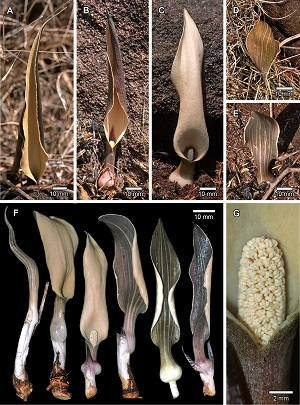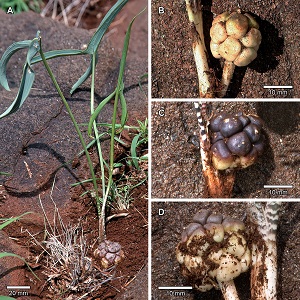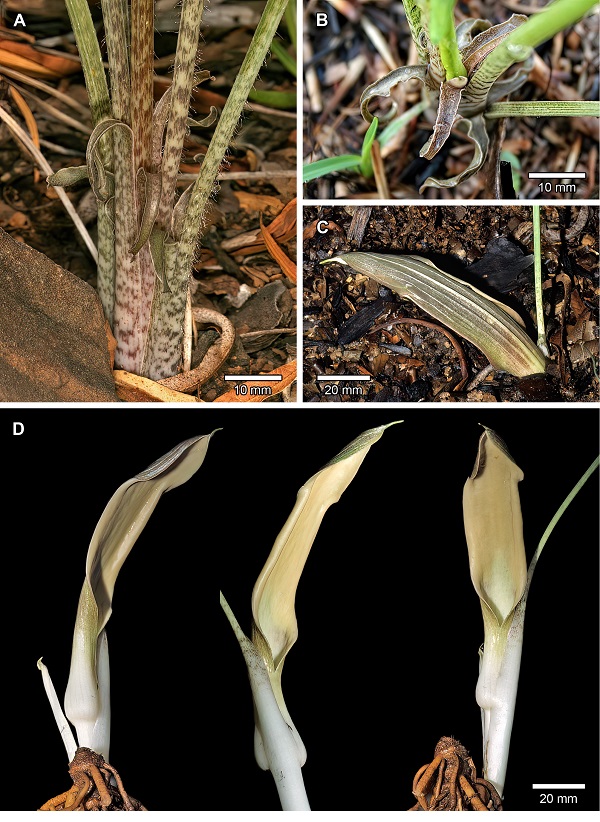If you think you have seen arum lilies in all their beautiful shapes, sizes and colours, you are in for a surprise: two new species were recently discovered in the Sekhukhuneland bushveld where these plants grow naturally and spectacularly.
Researchers from the North-West University (NWU), in collaboration with a researcher from the University of Pretoria (UP), have discovered and scientifically described brand-new species of this impressive indigenous group of plants that are closely related to the pig lilies. The discovery of two species is especially remarkable as until this year, only one bushveld arum lily (Stylochaeton natalense) was known in South Africa.
The research team has now added Stylochaeton glaucophyllum (blue bushveld arum) and Stylochaeton sekhukhuniense (Sekhukhuneland bushveld arum) to this genus of arum lilies.
The local team comprises Prof Stefan Siebert and Dr Madeleen Struwig from the NWU’s campuses in Potchefstroom and Mahikeng respectively, and Ms Tshireletso le Roux, a botany student from the NWU’s Mahikeng Campus. The fourth team member is Prof Braam van Wyk, a retired researcher from UP, who is also an NWU alumnus and recipient of a 2015 NWU Alumni Excellence award.
What makes the collaboration between these researchers even more special is that it is based on the transfer of knowledge over many years. Prof Van Wyk was Prof Siebert’s study leader during his PhD studies, Prof Siebert was in turn Dr Struwig’s study leader and Ms Le Roux is Dr Struwig’s student.
Dig a little deeper to discover their fruits
Prof Siebert says the discovery of the two species came during geoecological research on ultramafic (metal-rich) rocks around Steelpoort in Sekhukhuneland. The term geoecological refers to interdisciplinary and multidisciplinary science that integrates geosciences with life sciences.
“The species were previously overlooked because their flowers are two-thirds subterranean and their leaves, to the untrained eye, resemble that of the common species,” says Dr Struwig.
He explains that they were always and easily mistaken for the commonly occurring bushveld arum lily, which carries its inflorescence and fruits 5 cm to 10 cm above ground. In the arum family, the beautiful “flower”, such as that of the popular Calla lily, is in fact an inflorescence which is made up of tiny flowers that are clustered tightly together on a spike (called a spadix) and wrapped (or concealed in the case of the new species) by a leaf-like, coloured structure called a spathe.
These newly discovered species are different because they are much smaller than the known species and their fruits are nearly entirely buried below ground. The plants also grow in harsh environments of metal-rich rocky soil, which Prof Siebert says can explain why they are smaller.
Taxonomic research over the course of several years has proven the teams’ initial observations that these were indeed new species and not variations of the commonly known species.
“Considering that a genus that always had just one species in South Africa now has three members, is not only a major discovery, but also an indication of the immense hidden plant diversity of South Africa,” says Prof Siebert.
When it comes to arum lilies, this discovery proved to be only the beginning for the team. During this year, they have also discovered a further two species of bushveld arums with subterranean fruit in the Barberton region. They are currently researching these before they can officially declare them as new species. This might increase the number of bushveld arum lily species in South Africa from one to five.
“We believe there is much more to discover about these plants and are excited about the new research avenues the discovery has opened for us,” concludes Prof Siebert.
To read the first published paper on the arum lilies,click here

Figure 3: The recently discovered species of arum lilies are Stylochaeton glaucophyllum and Stylochaeton sekhukhuniense. These photos show the structure of the plant’s inflorescence, which are its stems, stalks, bracts and flowers. All photos: © 2023 Magnolia Press, CC BY-SA 4.0.

Figure 4: The Stylochaeton glaucophyllum’s shapes and arrangement of its parts. It shows the plant with mature fruit below ground up to where it is mainly borne below ground. All photos: © 2023 Magnolia Press, CC BY-SA 4.0.

Figure 7: The Stylochaeton sekhukhuniense’s morphology of leaves and inflorescence from the basal part of the leaves to where the inflorescences are removed from the plant and soil and cleaned from the basal parts. All photo’s: © 2023 Magnolia Press, CC BY-SA 4.0.
*For a full and scientific description of each figure, click here
The members of the research team that made the discovery of the brand-new species of bushveld arum lilies are Prof Stefan Siebert, Dr Madeleen Struwig, Prof Braam van Wyk and Ms Tshireletso le Roux.
Dr Madeleen Struwig

Ms Tshireletso le Roux.

Prof Stefan Siebert

Prof Braam van Wyk
